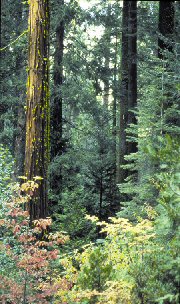WHAT'S NEW
FEATURED TOPICS
|
 |
FIVE MAJOR RESEARCH AREAS

A team of researchers is making significant contributions to assessing restoration efforts by defining, quantifying and understanding key functions that shape forest condition, structure, and composition. Our research goal is focused on providing forest managers with better tools for understanding and restoring Sierra Nevada forests. Research must help understand and describe a middle ground where fire has an importance ecological role and its controlled reintroduction to western forests is desired and feasible.
 The worldwide loss of biological diversity continues, largely in response to widespread habitat destruction, over-harvesting, pollution, and the accidental and otherwise inappropriate introduction of foreign plants and animals. To conserve the biological diversity of the Sierra Nevada it will be crucial to identify the vulnerable components of biological diversity, determine the threats to diversity, understand the response of organisms and ecosystems to the threats, determine restoration and recovery techniques, perform adaptive management projects and monitor recovery. The worldwide loss of biological diversity continues, largely in response to widespread habitat destruction, over-harvesting, pollution, and the accidental and otherwise inappropriate introduction of foreign plants and animals. To conserve the biological diversity of the Sierra Nevada it will be crucial to identify the vulnerable components of biological diversity, determine the threats to diversity, understand the response of organisms and ecosystems to the threats, determine restoration and recovery techniques, perform adaptive management projects and monitor recovery.

Climate has a profound influence in shaping the environment, natural
resources, the economy, and other aspects of life throughout the
world. High mountain systems, such as the Sierra Nevada, are uniquely
sensitive to anticipated global climate changes and act as "canaries
in the coal mine" to provide early signals of significant climate-driven
changes. The Sierra Nevada Research Center is responding to this
environmental force with a research team that addresses issues ranging
from basic research on ecological response to climate and landscape
change to applications in national forest management, conservation,
and restoration.
 Improved knowledge of aquatic and land interactions at local and watershed scales is essential to evaluate and design land management alternatives for stream and watershed resources. Restoration of the Sierra Nevada's forest watersheds to historic or desired conditions requires active management such as reintroduction of frequent, cool fires and removal of accumulated fuel loads. This problem area can address the multiple stressors often acting on aquatic ecosystems in forests: tree thinning/harvesting, fire, air pollution, climate variability, land use change, water diversion, grazing, and roads. Improved knowledge of aquatic and land interactions at local and watershed scales is essential to evaluate and design land management alternatives for stream and watershed resources. Restoration of the Sierra Nevada's forest watersheds to historic or desired conditions requires active management such as reintroduction of frequent, cool fires and removal of accumulated fuel loads. This problem area can address the multiple stressors often acting on aquatic ecosystems in forests: tree thinning/harvesting, fire, air pollution, climate variability, land use change, water diversion, grazing, and roads.
 Current institutional capacities to articulate problems, participate in strategic planning and investment, and influencepublic land and resource decision-making varies considerably across jurisdictions and geography. There is a need to better understand institutional constraints and opportunities, and how interests interact with resource management institutions, in the context of public land decision-making. Research is needed on a broad range of social, economic and institutional factors that affect landscapes and land use decisions in the Sierra Nevada and elsewhere. Current institutional capacities to articulate problems, participate in strategic planning and investment, and influencepublic land and resource decision-making varies considerably across jurisdictions and geography. There is a need to better understand institutional constraints and opportunities, and how interests interact with resource management institutions, in the context of public land decision-making. Research is needed on a broad range of social, economic and institutional factors that affect landscapes and land use decisions in the Sierra Nevada and elsewhere.
|

| About Us |
The
Sierra Nevada Research Center
has locations in Albany, Davis and Fresno, California. It is a research work unit of the Pacific Southwest Research Station, headquartered in Albany, California. The unit and research station are part of the Forest Service, U.S. Department of Agriculture.
|
| |
|